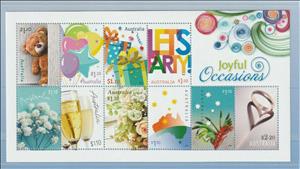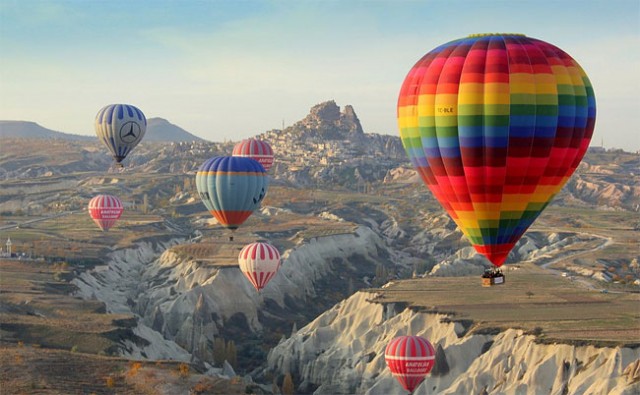Mini Sheet: Joyful Occasions (Australia 2020)
Joyful Occasions (Australia 2020)
02 January (Australia ) within release Joyful Occasions (2020) goes into circulation Mini Sheet Joyful Occasions face value 12.10 Australian dollar
| Mini Sheet Joyful Occasions in catalogues | |
|---|---|
| Colnect codes: | Col: AU 2020-01MS |
Mini Sheet is horizontal format.
Sold by Australia Post in special folders for Au$12.55Also in the issue Joyful Occasions (2020):
- Stamp - Balloons face value 1.10;
- Stamp - Bouquet of Roses face value 1.10;
- Stamp - Gifts face value 1.10;
- Stamp - Let's Party! face value 1.10;
- Stamp - Map Of Australia & Southern Cross face value 1.10;
- Stamp - Bouquet of Roses face value 1.10;
- Stamp - Wedding Ring face value 2.20;
- Stamp - Teddy Bear face value 1.10;
- Stamp - Let's Party! face value 1.10;
- Stamp - Champagne Glasses face value 1.10;
- Stamp - Gifts face value 1.10;
- Stamp - Flowers face value 1.10;
- Stamp - Champagne Glasses face value 1.10;
- Stamp - Teddy Bear face value 1.10;
- Stamp - Gifts face value 1.10;
- Stamp - Flowers face value 1.10;
- Stamp - Kangaroo Paw and Southern Cross face value 1.10;
- Stamp - Wedding Ring face value 2.20;
- Mini Sheet - Joyful Occasions face value 12.10;
- Booklet - Teddy Bear Booklet face value 10*1.10;
- Booklet - Balloon Booklet face value 10*1.10;
- Booklet - Gift Booklet face value 10*1.10;
- Booklet - Let's Party! Booklet face value 10*1.10;
- Booklet - Flowers Booklet face value 10*1.10;
- Booklet - Champagne glasses Booklet face value 10*1.10;
- Booklet - Bouquet of Roses Booklet face value 10*1.10;
Mini Sheet Joyful Occasions it reflects the thematic directions:
A hot air balloon is a lighter-than-air aircraft consisting of a bag, called an envelope, which contains heated air. Suspended beneath is a gondola or wicker basket (in some long-distance or high-altitude balloons, a capsule), which carries passengers and a source of heat, in most cases an open flame caused by burning liquid propane. The heated air inside the envelope makes it buoyant, since it has a lower density than the colder air outside the envelope. As with all aircraft, hot air balloons cannot fly beyond the atmosphere. The envelope does not have to be sealed at the bottom, since the air inside the envelope is at about the same pressure as the surrounding air. In modern sport balloons the envelope is generally made from nylon fabric, and the inlet of the balloon (closest to the burner flame) is made from a fire-resistant material such as Nomex. Modern balloons have been made in many shapes, such as rocket ships and the shapes of various commercial products, though the traditional shape is used for most non-commercial and many commercial applications.
The hot air balloon is the first successful human-carrying flight technology. The first untethered manned hot air balloon flight in the world was performed in Paris, France, by Jean-François Pilâtre de Rozier and François Laurent d'Arlandes on November 21, 1783, in a balloon created by the Montgolfier brothers. The first hot air balloon flown in the Americas was launched from the Walnut Street Jail in Philadelphia on January 9, 1793, by the French aeronaut Jean Pierre Blanchard. Hot air balloons that can be propelled through the air rather than simply drifting with the wind are known as thermal airships.
A flower, sometimes known as a bloom or blossom, is the reproductive structure found in plants that are floral (plants of the division Magnoliophyta, also called angiosperms). The biological function of a flower is to effect reproduction, usually by providing a mechanism for the union of sperm with eggs. Flowers may facilitate outcrossing (fusion of sperm and eggs from different individuals in a population) or allow selfing (fusion of sperm and egg from the same flower). Some flowers produce diaspores without fertilization (parthenocarpy). Flowers contain sporangia and are the site where gametophytes develop. Many flowers have evolved to be attractive to animals, so as to cause them to be vectors for the transfer of pollen. After fertilization, the ovary of the flower develops into fruit containing seeds. In addition to facilitating the reproduction of flowering plants, flowers have long been admired and used by humans to beautify their environment, and also as objects of romance, ritual, religion, medicine and as a source of food.
personal ornaments, such as necklaces, rings, or bracelets, that are typically made from or contain jewels and precious metal.A map is a symbolic depiction emphasizing relationships between elements of some space, such as objects, regions, or themes. Many maps are static, fixed to paper or some other durable medium, while others are dynamic or interactive. Although most commonly used to depict geography, maps may represent any space, real or imagined, without regard to context or scale, such as in brain mapping, DNA mapping, or computer network topology mapping. The space being mapped may be two dimensional, such as the surface of the earth, three dimensional, such as the interior of the earth, or even more abstract spaces of any dimension, such as arise in modeling phenomena having many independent variables. Although the earliest maps known are of the heavens, geographic maps of territory have a very long tradition and exist from ancient times. The word "map" comes from the medieval Latin Mappa mundi, wherein mappa meant napkin or cloth and mundi the world. Thus, "map" became the shortened term referring to a two-dimensional representation of the surface of the world.
A gift or a present is an item given to someone, without the expectation of payment or anything in return. An item is not a gift if that item is already owned by the one to whom it is given. Although gift-giving might involve an expectation of reciprocity, a gift is meant to be free. In many countries, the act of mutually exchanging money, goods, etc. may sustain social relationship and contribute to social cohesion. Economists have elaborated the economics of gift-giving into the notion of a gift economy. By extension, the term gift can refer to any item or act of service that makes the other happier or less sad, especially as a favour, including forgiveness and kindness. Gifts are often presented on occasions such as birthdays and holidays.
A teddy bear is a stuffed toy in the form of a bear. Developed apparently simultaneously by toymakers Morris Michtom in the U.S. and Richard Steiff under his aunt Margarete Steiff's company in Germany in the early 20th century, the teddy bear, named after President Theodore Roosevelt, became a popular children's toy and has been celebrated in story, song, and film






